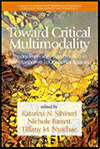
Toward Critical Multimodality
Theory, Research, and Practice in Transformative Educational Spaces
Edited by:
Katarina Silvestri, SUNY Cortland
Nichole Barrett, The Rural Outreach Center
Tiffany M. Nyachae, The Pennsylvania State University
A volume in the series: Contemporary Perspectives on Semiotics in Education: Signs, Meanings and Multimodality. Editor(s): Katarina Silvestri, SUNY Cortland. Mary McVee, University at Buffalo, SUNY. Jennifer D. Turner, University of Maryland College Park. Raúl Alberto Mora, Universidad Pontificia Bolivariana.
Published 2023
This edited volume seeks to answer the question, “What does it mean to be a critical multimodal scholar in educational spaces?” Toward Critical Multimodality highlights how choices made throughout multimodal design and research processes are critically-oriented and inextricably linked to power. We show how social semiotics and multimodality inform engagement with criticality in educational spaces through questioning dominant narratives (e.g., white, cisheteropatriarchal, ableist, classist perspectives), exploring relationships between selves and space, problematizing and reimagining educational practices, and dreaming of educational futures that are just, anti-oppressive, and with room for all to thrive while learning.
These chapters demonstrate how studying multiple modalities in interaction (e.g., image, writing, color, spatial layout, gaze, proxemics, gestures) can reveal how power operates, provide students with opportunities to explore themselves and their identities with respect to power, and provide a vehicle for scholars to disrupt and transform oppressive educational practices. Furthermore, multiple chapters show alternative ways to display, construct and share knowledge as transformative pedagogical practice in learning environments. We reframe social semiotics and multimodality as an integral part of decentering dominant ideas of power and what “counts” as purposeful meaning making by highlighting how criticality and multimodality integrate theoretically and methodologically.
CONTENTS
Prologue: AERA Chairs Introductory Remarks April 22, 2022 in Session Toward Critical Multimodality: Exploring Theory, Research, and Practice in Transformative Educational Spaces, Katarina N. Silvestri, Nichole Barrett, Tiffany M. Nyachae. Acknowledgments. Troubling, Disrupting, and Reimagining Educational Spaces: The Need for Critical Multimodality Now, Katarina N. Silvestri, Nichole Barrett, and Tiffany M. Nyachae. SECTION I: THEORIZING FOR CRITICAL MULTIMODALITY. Multimodal Meaning Making in a Pandemic: Visions From the Multilingual Periphery as Epicenter, Eunjeong Lee, Sara P. Alvarez, Laura Gonzales, and Amy J. Wan. Proceduralized Ideologies in Video Games and Playable Media, Earl Aguilera, Jeffrey B. Holmes, Kelly M. Tran, and Lynette D. Guzmán. Meet Me in Outer Space: Theorizing Fugitive Spaces of Creation and Joy With Girls of Color, Autumn A. Griffin and Grace D. Player. Multimodality as Accessibility: A Critical Perspective of Universal Design in Theory, Research, and Practice, Kyesha M. Isadore and Angélica Galván. SECTION II: CRITICAL MULTIMODALITY AND STORYTELLING FOR AGENCY AND REVISIONING. All the Stars Are Closer: Black Girl Multimodal Practices for Time Traveling in a Dystopian World, ThedaMarie Gibbs Grey, Jennifer D. Turner, and Alexis Morgan Young. Black Joy, Love, and Resistance: Using Digital Storytelling to Center Black Students’ Full Humanity, Davena Jackson. It Starts With a (Digital) Story: Agentive Inquiry Through Digital Storytelling, Andrea N. Franyutti-Boyles, Sara Cooper, and Gregory Ramírez. SECTION III: CRITICAL MULTIMODALITY FOR REIMAGINING CURRICULUM. “Don’t Tell Me It’s Not Research”: Using Multimodal Critical Inquiry Projects to Disrupt the Deficits in the Traditional ELA Paper, Sarah M. Fleming. The Plat and the Gavel: Multimodal Critical Family History in Rural Teacher Education, William S. Davis and Vicki Mokuria. Critical Multimodality at the Museum: How a Community–University Partnership Supports Transformative Praxis, Matthew R. Deroo. SECTION IV: CRITICAL MULTIMODALITY IN PROTESTS AND SOCIAL MOVEMENTS. Bordados: A Feminist Collective Practice of Resistance and Solidarity in the Chilean Estallido, Romina S. Peña-Pincheira, M. Isidora Bilbao-Nieva, and Lau Romero-Quintana. Post-it, Milk Tea, and Mini-Stonehenge: Making Sense of the Multimodality of Protest Artifacts in 2019–2020 Hong Kong Protest Movement, Jason Man-Bo Ho. Disrupting Discourses in Place: Youth, Space, and Activism, Amy Walker. Epilogue, Mary B. McVee. About the Editors. About the Contributors.
-
Paperback979-8-88730-248-5
Web price: $45.04 (Reg. 52.99)
-
Hardcover979-8-88730-249-2
Web price: $80.74 (Reg. 94.99)
- eBook979-8-88730-250-8

- EDU029000 - EDUCATION: TEACHING METHODS & MATERIALS: General
- EDU051000 - EDUCATION: Learning Styles
- EDU021000 - EDUCATION: Non-Formal Education
-
 American Educational History Journal - Golden Anniversary Edition
Volume 50 Numbers 1 & 2
American Educational History Journal - Golden Anniversary Edition
Volume 50 Numbers 1 & 2
-
 Cultivating Democratic Literacy Through the Arts
Guiding Preservice Teachers Towards Innovative Learning Spaces in ELA Classrooms
Cultivating Democratic Literacy Through the Arts
Guiding Preservice Teachers Towards Innovative Learning Spaces in ELA Classrooms
-
 Effective Alternative Assessment Practices in Higher Education
Effective Alternative Assessment Practices in Higher Education
-
 Frameworks for Integrated Project-Based Instruction in STEM Disciplines
Frameworks for Integrated Project-Based Instruction in STEM Disciplines
-
 Narratives of TESOL Professionals
Experiences Navigating the Doctoral Program
Narratives of TESOL Professionals
Experiences Navigating the Doctoral Program
-
 Quarterly Review of Distance Education
Volume 24 #1
Quarterly Review of Distance Education
Volume 24 #1
-
 Supporting Leaders for School Improvement Through Self-Care and Wellbeing
Supporting Leaders for School Improvement Through Self-Care and Wellbeing

